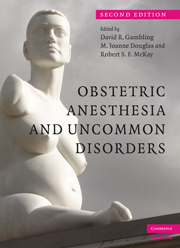Book contents
- Frontmatter
- Contents
- List of plates
- List of contributors
- Preface
- Section 1 Cardiovascular and respiratory disorders
- Section 2 Musculoskeletal disorders
- 5 Myopathies
- 6 Parturients of short stature
- 7 Disorders of the vertebral column
- 8 Miscellaneous skeletal and connective tissue disorders in pregnancy
- Section 3 Nervous system disorders
- Section 4 Metabolic disorders
- Section 5 Other disorders
- Index
- Plate Section
- References
6 - Parturients of short stature
from Section 2 - Musculoskeletal disorders
Published online by Cambridge University Press: 19 October 2009
- Frontmatter
- Contents
- List of plates
- List of contributors
- Preface
- Section 1 Cardiovascular and respiratory disorders
- Section 2 Musculoskeletal disorders
- 5 Myopathies
- 6 Parturients of short stature
- 7 Disorders of the vertebral column
- 8 Miscellaneous skeletal and connective tissue disorders in pregnancy
- Section 3 Nervous system disorders
- Section 4 Metabolic disorders
- Section 5 Other disorders
- Index
- Plate Section
- References
Summary
Introduction
Dwarfism is defined as failure to achieve a height of 4 feet 10 inches (148 cm) at adulthood. Short stature is a clinical entity that has numerous etiologies. These conditions can be of genetic, constitutional, or metabolic origin. There are more than 100 different types of dwarfism, none of which is very common. The most common variety, achondroplasia, occurs in only 0.5 to 1.5 per 10,000 live births. Two major classifications of dwarfism are especially useful to the anesthesiologist: (1) patients with short stature who are proportionate and have normal trunk-to-limb ratio, and (2) patients who have disproportionate growth and have either short trunks in relation to their limbs or short limbs in relation to their trunks. (see Table 6.1). There are women at the lower extreme of height in some cultures who would meet the definition of dwarfism but who have no medical pathology. Their treatment must be individualized bearing in mind that they may be similar in some respects to parturients with proportionate dwarfism.
Since the formation of the Little People of America, a society for people of short stature, and even dedicated online dating services, much greater opportunity exists for dwarfs to meet, socialize, and eventually have children. In addition, increased use of assisted reproductive technology is enabling women of short stature who were otherwise infertile to achieve pregnancy and even multiple gestations.
- Type
- Chapter
- Information
- Obstetric Anesthesia and Uncommon Disorders , pp. 115 - 128Publisher: Cambridge University PressPrint publication year: 2008



